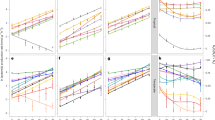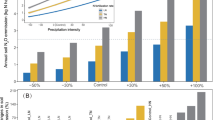Abstract
Soil nitrous oxide (N2O) is an important greenhouse gas contributing to climate change. Many processes produce N2O in soil and the production rate of each process is affected by climatic-edaphic factors, making the soil-to-atmosphere N2O flux extremely dynamic. Experimental approaches, including natural and enriched isotopic methods, have been developed to separate and quantify the N2O production from different processes. However, these methods are often costly and tedious, hampering their wide application. This study aimed to develop a mechanistic model quantifying the soil N2O production from nitrifier nitrification (NN), nitrifier denitrification (ND), and heterotrophic denitrification (HD), which are considered as the most important biological processes, and to investigate how climatic-edaphic factors affect N2O production from individual process as well as total N2O production. The developed model demonstrated its robustness and capability by reliably reproducing the N2O production from NN, ND, and HD in different types of soils under various moisture contents or oxygen concentrations. The model simulations unraveled how environmental conditions and soil properties control the total N2O production rate by variably regulating individual processes. Therefore, the mechanistic model can potentially elucidate the large spatiotemporal variances of in-situ soil N2O flux and improve the assessment of soil N2O emission at regional and global scales.






Similar content being viewed by others
Data availability
All codes and data used in this study are freely available from the corresponding author upon request.
References
Butterbach-Bahl K, Baggs EM, Dannenmann M, Kiese R, Zechmeister-Boltenstern S (2013) Nitrous oxide emissions from soils: how well do we understand the processes and their controls? Philosophical Transactions of the Royal Society b: Biological Sciences 368:20130122
Caranto JD, Lancaster KM (2017) Nitric oxide is an obligate bacterial nitrification intermediate produced by hydroxylamine oxidoreductase. Proc Natl Acad Sci 114:8217–8222
Castellano MJ, Schmidt JP, Kaye JP, Walker C, Graham CB, Lin H, Dell CJ (2010) Hydrological and biogeochemical controls on the timing and magnitude of nitrous oxide flux across an agricultural landscape. Glob Change Biol 16:2711–2720
Chamindu Deepagoda TKK, Jayarathne JRRN, Clough TJ, Thomas S, Elberling B (2019) Soil-Gas Diffusivity and Soil-Moisture effects on NO Emissions from Intact Pasture Soils. Soil Sci Soc Am J 83:1032–1043
Chen Z, Ding W, Xu Y, Müller C, Yu H, Fan J (2016) Increased N2O emissions during soil drying after waterlogging and spring thaw in a record wet year. Soil Biol Biochem 101:152–164
Chen X, Ni BJ, Sin G (2019) Nitrous oxide production in autotrophic nitrogen removal granular sludge: A modeling study. Biotechnol Bioeng 116:1280–1291
Ciarlo E, Conti M, Bartoloni N, Rubio G (2007) The effect of moisture on nitrous oxide emissions from soil and the N2O/(N2O+N2) ratio under laboratory conditions. Biol Fertil Soils 43:675–681
Davidson EA, Keller M, Erickson HE, Verchot LV, Veldkamp E (2000) Testing a Conceptual Model of Soil Emissions of Nitrous and Nitric Oxides. Bioscience 50:667–680
Dobbie KE, Smith KA (2003) Nitrous oxide emission factors for agricultural soils in Great Britain: the impact of soil water-filled pore space and other controlling variables. Glob Change Biol 9:204–218
Duan P, Song Y, Li S, Xiong Z (2019) Responses of N2O production pathways and related functional microbes to temperature across greenhouse vegetable field soils. Geoderma 355:113904
Firestone M, Davidson E (1989) Microbiological basis of NO and N2O production and consumption in soil. Exchange of Trace Gases between Terrestrial Ecosystems and the Atmosphere 47:7–21
Hénault C, Grossel A, Mary B, Roussel M, Léonard J (2012) Nitrous oxide emission by agricultural soils: a review of spatial and temporal variability for mitigation. Pedosphere 22:426–433
Hu H, Chen D, He J (2015) Microbial regulation of terrestrial nitrous oxide formation: understanding the biological pathways for prediction of emission rates. FEMS Microbiol Rev 39:729–749
Huang T, Gao B, Hu X, Lu X, Well R, Christie P, Bakken LR, Ju X (2015) Ammonia-oxidation as an engine to generate nitrous oxide in an intensively managed calcareous Fluvo-aquic soil. Sci Rep 4:03950
Klier C, Gayler S, Haberbosch C, Ruser R, Stenger R, Flessa H, Priesack E (2011) Modeling nitrous oxide emissions from potato-cropped soil. Vadose Zone Journal 10:184–194
Kool DM, Wrage N, Oenema O, Dolfing J, Van Groenigen JW (2007) Oxygen exchange between (de)nitrification intermediates and H2O and its implications for source determination of NO3− and N2O: a review. Rapid Commun Mass Spectrom 21:3569–3578
Kool DM, Müller C, Wrage N, Oenema O, Van Groenigen JW (2009) Oxygen exchange between nitrogen oxides and H2O can occur during nitrifier pathways. Soil Biol Biochem 41:1632–1641
Kool DM, Dolfing J, Wrage N, Van Groenigen JW (2011) Nitrifier denitrification as a distinct and significant source of nitrous oxide from soil. Soil Biol Biochem 43:174–178
Kravchenko AN, Toosi ER, Guber AK, Ostrom NE, Yu J, Azeem K, Rivers ML, Robertson GP (2017) Hotspots of soil N2O emission enhanced through water absorption by plant residue. Nat Geosci 10:496–500
Laville P, Lehuger S, Loubet B, Chaumartin F, Cellier P (2011) Effect of management, climate and soil conditions on N2O and NO emissions from an arable crop rotation using high temporal resolution measurements. Agric for Meteorol 151:228–240
Li C, Aber J, Stange F, Butterbach-Bahl K, Papen H (2000) A process-oriented model of N2O and NO emissions from forest soils: 1. Model development. J Geophys Res 105:4369–4384
Maggi F, Gu C, Riley WJ, Hornberger GM, Venterea RT, Xu T, Spycher N, Steefel C, Miller NL, Oldenburg CM (2008) A mechanistic treatment of the dominant soil nitrogen cycling processes: Model development, testing, and application. J Geophys Res Biogeosci 113:G02016
Mathieu O, Leveque J, Henault C, Milloux M, Bizouard F, Andreux F (2006) Emissions and spatial variability of N2O, N2 and nitrous oxide mole fraction at the field scale, revealed with 15N isotopic techniques. Soil Biol Biochem 38:941–951
Müller C, Laughlin RJ, Spott O, Rütting T (2014) Quantification of N2O emission pathways via a 15N tracing model. Soil Biol Biochem 72:44–54
Ni B-J, Peng L, Law Y, Guo J, Yuan Z (2014) Modeling of nitrous oxide production by autotrophic ammonia-oxidizing bacteria with multiple production pathways. Environ Sci Technol 48:3916–3924
Peng L, Ni B-J, Erler D, Ye L, Yuan Z (2014) The effect of dissolved oxygen on N2O production by ammonia-oxidizing bacteria in an enriched nitrifying sludge. Water Res 66:12–21
Pilegaard K (2013) Processes regulating nitric oxide emissions from soils. Phil Trans Royal Society B 368:20130126
Prosser JI, Hink L, Gubry-Rangin C, Nicol GW (2020) Nitrous oxide production by ammonia oxidizers: Physiological diversity, niche differentiation and potential mitigation strategies. Glob Change Biol 26:103–118
Sander R (2015) Compilation of Henry’s law constants (version 4.0) for water as solvent. Atmos Chem Phys 15:4399–4981
Sieczka A, Koda E (2016) Kinetic and equilibrium studies of sorption of ammonium in the soil-water environment in agricultural areas of Central Poland. Appl Sci 6:269
Song X, Liu M, Ju X, Gao B, Su F, Chen X, Rees RM (2018) Nitrous oxide emissions increase exponentially when optimum nitrogen fertilizer rates are exceeded in the North China Plain. Environ Sci Technol 52:12504–12513
Song X, Ju X, Topp CFE, Rees RM (2019) Oxygen regulates nitrous oxide production directly in agricultural soils. Environ Sci Technol 53:12539–12547
Tian H, Yang J, Lu C, Xu R, Canadell JG, Jackson RB, Arneth A, Chang J, Chen G, Ciais P (2018) The Global N2O Model Intercomparison Project. Bull Am Meteor Soc 99:1231–1251
Tian H, Xu R, Canadell JG, Thompson RL, Winiwarter W, Suntharalingam P, Davidson EA, Ciais P, Jackson RB, Janssens-Maenhout G, Prather MJ, Regnier P, Pan N, Pan S, Peters GP, Shi H, Tubiello FN, Zaehle S, Zhou F, Arneth A, Battaglia G, Berthet S, Bopp L, Bouwman AF, Buitenhuis ET, Chang J, Chipperfield MP, Dangal SRS, Dlugokencky E, Elkins JW, Eyre BD, Fu B, Hall B, Ito A, Joos F, Krummel PB, Landolfi A, Laruelle GG, Lauerwald R, Li W, Lienert S, Maavara T, Macleod M, Millet DB, Olin S, Patra PK, Prinn RG, Raymond PA, Ruiz DJ, Van Der Werf GR, Vuichard N, Wang J, Weiss RF, Wells KC, Wilson C, Yang J, Yao Y (2020) A comprehensive quantification of global nitrous oxide sources and sinks. Nature 586:248–256
van den Heuvel RN, Hefting MM, Tan NCG, Jetten MSM, Verhoeven JTA (2009) N2O emission hotspots at different spatial scales and governing factors for small scale hotspots. Sci Total Environ 407:2325–2332
van der Weerden TJ, Kelliher FM, de Klein CAM (2012) Influence of pore size distribution and soil water content on nitrous oxide emissions. Soil Research 50:125–135
Wrage N, Horn MA, Well R, Müller C, Velthof G, Oenema O (2018) The role of nitrifier denitrification in the production of nitrous oxide revisited. Soil Biol Biochem 123:A3–A16
Yan Z, Liu C, Todd-Brown KE, Liu Y, Bond-Lamberty B, Bailey VL (2016) Pore-scale investigation on the response of heterotrophic respiration to moisture conditions in heterogeneous soils. Biogeochemistry 131:121–134
Yan Z, Bond-Lamberty B, Todd-Brown KE, Bailey VL, Li S, Liu C, Liu C (2018) A moisture function of soil heterotrophic respiration that incorporates microscale processes. Nat Commun 9:2562
Zhang Y, Zhao W, Cai Z, Müller C, Zhang J (2018) Heterotrophic nitrification is responsible for large rates of N2O emission from subtropical acid forest soil in China. Eur J Soil Sci 69:646–654
Zhu X, Burger M, Doane TA, Horwath WR (2013) Ammonia oxidation pathways and nitrifier denitrification are significant sources of N2O and NO under low oxygen availability. Proc Natl Acad Sci 110:6328–6333
Acknowledgements
We would like to thank Dr. Klaus Butterbach-Bahl from the Karlsruhe Institute of Technology (KIT), Ms. Hui Wang and Dr. Yiwen Liu from Tianjin University, Dr. Tao Huang from Nanjing Normal University, Dr. Qian Zhang from University of Maryland Center for Environmental Science for their constructive suggestions and comments, and two anonymous reviewers whose comments improved the paper. This work was financially supported by the National Natural Science Foundation of China (42077009) and the Haihe Laboratory of Sustainable Chemical Transformations.
Author information
Authors and Affiliations
Contributions
All co-authors contributed to the study. BC and ZY wrote the numerical codes and run the simulations. XJ, XS, YL, and XZB helped to analyze the data. BC wrote the first draft. ZY, SL, PF, and XZ contributed to improve the manuscript.
Corresponding author
Ethics declarations
Conflict of interest
The authors declare no conflict of interest.
Additional information
Responsible Editor: Feng Zhou.
Publisher's Note
Springer Nature remains neutral with regard to jurisdictional claims in published maps and institutional affiliations.
Supplementary Information
Below is the link to the electronic supplementary material.
Rights and permissions
About this article
Cite this article
Chang, B., Yan, Z., Ju, X. et al. Quantifying biological processes producing nitrous oxide in soil using a mechanistic model. Biogeochemistry 159, 1–14 (2022). https://doi.org/10.1007/s10533-022-00912-0
Received:
Accepted:
Published:
Issue Date:
DOI: https://doi.org/10.1007/s10533-022-00912-0




